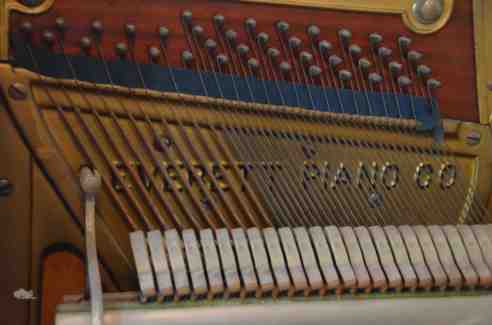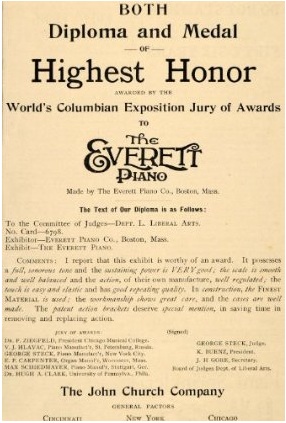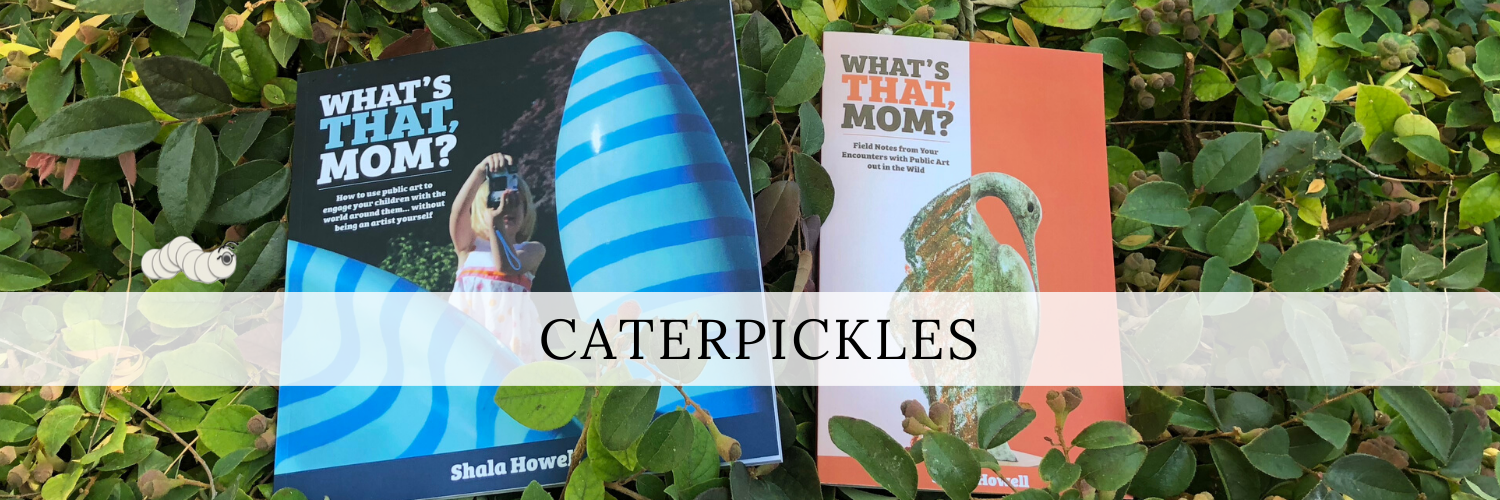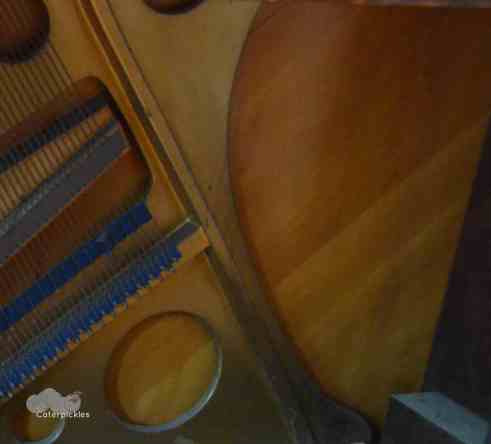“Is our piano an endangered species?”

Our 1901 Everett upright. I’d love to claim that this piano was handed down to me through the generations, but the fact is we acquired it when we bought our first house in Hyde Park, MA 11 (12?) years ago. (Photo: Shala Howell)
A couple of weeks ago — the Monday after Endangered Species day in fact — I had Joe Morocco, pianoman out to repair and tune our old Everett piano.
The highest C hasn’t worked on the piano for at least seven years. I have been hanging on to the piece needed to repair it for all that time without doing anything about it. (I mean really, aside from toddlers and concert pianists who actually plays the highest C?) Repairing it just didn’t feel critical. But lately, for various reasons, I began to think that my luck in keeping track of this random little hammer was about to run out.
In the process of stripping my old Everett down to its metal harp so that he could repair and replace the hammer, Joe Morocco gave me quite an education both about my piano and the world in which it was constructed.

Our Everett with the mahogany veneer stripped off, exposing the pin block, brass rail, metal harp, and sound board (the wood behind the metal) inside. That’s Joe Morocco in the corner using a ladies’ hair straightener to prep the broken hammer for installation. (Photo: Shala Howell)
Five Reasons My Everett is an Endangered Species
1) Based on its serial number (31862), my piano was built in 1901 in a piano factory on Washington Street in Boston and sold on Boylston.
Only 800 Everetts were built that year, and relatively few remain in the wild today. So in that sense, my piano is an endangered species. But not nearly as endangered as U.S. piano manufacturers themselves. In 1901, all pianos were made and sold locally. There were 300 piano manufacturers in Boston alone, and countless others in places like Chicago, New York City, and Cincinnati. Today there is only one piano manufacturer in the entire United States — Steinway.
2) Piano manufacturers in the 1900s preferred to make piano strings out of copper, because copper creates a superior tone.
But a copper shortage around the time my piano was constructed forced Everett to use copper strings for the ten lowest tones only, and steel for the rest. If you listen carefully, you can actually hear the change in sound quality between the notes. (The steel strings have a more nasal tone.)

Closeup of a portion of the pin block in my Everett, showing the transition from copper to steel strings. Incidentally, my piano has an exposed pin block, an older style of construction in which the metal harp wraps around the pins but doesn’t cover them. In newer models, the metal harp covers the pin block and has a series of holes through which piano tuners access the pins. (Photo: Shala Howell)
3) The sound board in my piano is made of spruce wood with at least 13 sap lines per inch.
The number (and straightness) of the sap lines matters because it affects the sound board’s ability to vibrate. Someone somewhere figured out that at least 13 straight sap lines per inch were required to produce the Everett sound, and that was the standard to which all Everett pianos were built. (Oh, and that buzzing sound you hear when you play the F sharp below middle C? That’s because my sound board is cracked. Bummer.)
4) The sound boards in modern pianos are built to support an A440 standard pitch (essentially this means that the A above middle C is set to a frequency of 440Hz, and the other notes on the piano are tuned accordingly).

Super picky attention to details like the number of sap lines in their sound boards was one of the reasons the Boston Everett Piano company took home top honors from the 1893 Columbian Exposition in Chicago. (Image via Amazon)
Setting a standard pitch for the A above middle C enables instruments from around the world to play together without setting off a chorus of protesting cats in the alley behind the concert hall. The sound board in my Everett was built to support an earlier standard, A435, the pitch standard recommended by the Austrian government in 1885.
5) But what really makes my piano an endangered species is the fact that its tiger grain mahogany veneer is made of Honduras mahogany (Swietenia humilis).
It’s not exactly an extinct species, but the Honduran mahogany stands were logged so extensively over the past few centuries to meet demand for mahogany furniture in the United States and Europe that Honduras mahogany is considered commercially extinct today. Although stands of this slow-growing tree still exist, Honduras mahogany is heavily regulated and no longer widely used to make furniture.
And that means, instead of dragging The Six-Year-Old to the Arnold Arboretum to hunt for endangered species on Endangered Species day, I could have simply walked her into the front room and introduced her to our very old piano.
Related Link:
- Find the Age of your Everett (Yamaha)
- Everett Piano Company (Wikipedia)
- Mahogany Species Information (US Fish & Wildlife Service)
- The Six-Year-Old celebrates Take Your Tiger to Work day (Caterpickles)


16 Responses to ““Is our piano an endangered species?””
[…] Moving a piano is gruesome work and kind of hard on the piano, so we decided to store our ancient historically interesting (at least to me) Everett upright piano until we had found a place of our […]
LikeLike
Hi Shala, I believe I may own the same piano! I have not had mine looked at yet but it was very interesting for me to find this post. By the looks of the photos you posted, I truly believe I may have a sister of your dear piano! Funny story of how we came to own ours… my Mum plays the piano and about 7 or 8 years ago my Dad bought her this piano as a birthday gift. A few years later, I ended up marrying a man with the last name Everett! My parents passed the pain to us as a gift when we moved into our new home. I have not been able to find a serial number on it although I have only given it a quick glance. I found one number engraved in the wood inside the piano “35338” that number doesn’t come up anywhere online when I look it up though. When you had your piano repaired, were you able to find out any details of the worth of the piano? I know it may not be worth much but it is dear to us and I would like to insure it for the proper amount. It is quite pricey to have a technician out to appraise it so I’ve just been doing some online research to see if I can find any information. Anything you may be able to tell me would be really helpful! I would love to hear all about yours! Thanks!
LikeLike
What a lovely present! I adore our Everett (obviously), and have gone to great lengths to keep it.
The number engraved inside is the serial number. You’re all set. So based on that and this, I’d say your piano is from 1904 (Yamaha absorbed the Everett piano company back in the day, and while Everetts are no longer being made, Yamaha has posted this chronological list of serial numbers to help people date them). Out of curiosity, when you look inside, do you have all copper strings stretching across the harp or are some of them made from steel? I would love to know how long that copper shortage lasted.
I’ve had several folks out to tune our piano over the years, and have asked all of them to tell me whatever they can about it. I’m afraid you’re right. There’s not much inherent value in your Everett (unless you’ve had it restored). Folks just aren’t buying uprights much any more. Like the people who gifted us our Everett when we bought our first house, most people prefer spinnets (the smaller, shorter pianos better suited for apartment life). Our Everetts are basically grand pianos hoisted onto their side, so are too loud and too big for most people to live with. The tuners I’ve had in to work on mine all uniformly quote a street value of no more than $300 because of this. “There are no antique pianos,” said my first tuner, “Just old ones.”
For insurance purposes, you’d be better off considering not what the piano is worth, but how much you’d have to spend to replace it. My husband and I would probably just get another used upright should anything happen to the Everett, so we lump it in with the rest of the house’s furnishings. But I’m not a serious musician. I’m just a historically curious person who happens to love tinkering on a piano now and then (my poor neighbors), and if that piano has a good backstory, all the better.
All bets are off though, if you’ve restored it. Restored Everetts run for $18K+. In that case, I would insure the piano for its own value, and would take the trouble of having it officially appraised. If you haven’t restored it, but are interested in seeing how much it would cost to do so, you can google “restore old pianos”. Several pages will come up with websites of folks who restore old pianos. Many of them will post price ranges for restoration work online. Others will give you estimates via emails based on pictures of your piano. Warning: Restoring runs in the $10K+ range. Consequently, we don’t plan to do it ourselves, although I remain hopeful that my husband will decide to do it for my 50th birthday. With luck, if he starts saving now, he just might be able to pull it out. Unless I decide I’d rather have a new kitchen. Decisions, decisions.
In the meantime, enjoy your Everett. They are great pianos and a ton of fun. If you search for “piano” on Caterpickles my posts about ours should come up. They pretty much exhaust my knowledge. 🙂
LikeLike
Thank you SO much for all the info! We do love ours as well. I don’t think we will be able to restore it for awhile but it is nice to hear the options! Our copper strings do not go all the way across. There are some steel strings as well.
Thanks again!
LikeLike
Hello there. I just aquired this piano, Everett 32499. according to the list, it is a 1903 piano. it is in fairly good shape. one of the highest keys vibrates, but other than that, it sounds pretty good. I got it for $200. the Mahogany wood is still in very good shape. just a few scratches here and there. and it still has the original sails ticket with it. I am very excited about the piano. I don’t know if I will ever have it restored, but I would love to have someone give me an estimate for restoring it and a price as is at this point. It only has partial copper. this blog was very helpful to me. thank you for posting it.
LikeLike
Congratulations on your Everett! I still adore mine. I did do a bit of digging a few years ago to see how much it would cost to restore it and found a company in the MidWest who would do it for ~$18,000. I decided to love mine the way it is. I don’t know if you like this sort of thing, but back in the day, they actually wrote piano music to celebrate the Everett. You can get a copy of the Everett March online here: https://jscholarship.library.jhu.edu/handle/1774.2/21965?show=full.
It’s kind of fun to play on an actual Everett. 🙂
Enjoy!
LikeLike
Here’s the website I found: https://antiquepianoshop.com/restoration-services/restoration-packages/upright-restoration-packages/. Obviously I didn’t end up using their services, so can’t vouch for them, but thought I’d share the website anyway as they have a fun page on Everetts, including a really fantastic catalog from the 1880s.
LikeLike
I have an Everett Upright Piano with a serial no. 29728. I purchased it primarily as an antique to go in my Music Room. It was originally tuned to A437, which was an international pitch at the time. I had a friend of mine who is a piano tuner, tune it to A440. He commented that the piano is in relatively good shape.
I am still researching to learn more. All of the Everett Serial No. charts indicate that it was manufactured in the late 1890’s. I was told by my 96 year old piano tuner friend that he thought it was made in 1892?
Any information to add would be appreciated.
LikeLike
Thanks for stopping by Caterpickles. I’m always happy to meet another Everett piano owner!
I really don’t have much to add to what you’ve already figured out, unfortunately. I would have directed you to the Everett Serial number charts for a precise dating, but I see that you’ve already done that.
Personally I have enjoyed tracking down old Everett piano ads to see if I can find more about my own model that way. It’s hit or miss, but I love seeing old-timey ads so it’s fun for me even if the day’s search doesn’t pan out.
Just Google “Everett piano ads” and a bunch of images will pop up. You can hone in on the ones from the years in question there to see if by any chance they resemble your own instrument.
You might also try contacting the folks at The Antique Piano Shop (http://antiquepianoshop.com/online-museum/everett/).
Finally, you can find some of the original sheet music used to sell Everett pianos back in the day online. I found a reproduction of the Everett Piano March online (this time google “Everett Piano March”). I get a kick out of playing it on my Everett. 😉
LikeLike
Shala,
Thanks for commenting.
As I stated, I actually bought the Everett as an antique for my Music Room. I purchased it from an Old Baptist Church basement in Chandler Mountain, Al.
I have been playing in Rock Bands since I was 16 yrs old and still playing with a group “Tyn Tymes”, We are a 10 piece horn band that plays almost all the old Soul Music of the 60’s. I do not play piano but am the Lead singer, play some trumpet and blues guitar. You may visit our Facebook site at Tyn Tymes.
This piano is fascinating and I am really interested in learning more. I thought that my guitar collection was worth a significant amount of money but the Everett may be worth more.
Again, thanks for responding
Jerry Rickles
LikeLike
I would be amazed if your Everett was worth more than your guitars. As my piano tuner said to me, “There are no antique pianos, just old ones.” The problem is there isn’t much of a market for old pianos to drive up the prices at auction. Apparently, pianos are not big collector’s items. Go figure.
But if you hear differently, I’d love to know.
Everetts are fascinating though. Eight Everetts pianos — two of them grands — were displayed at the 1893 Columbian Exposition and took top honors for being one of the best musical instruments at the Fair. I learned this from an old Everett Piano ad.
Lots of musicians — including John Philip Sousa — also widely endorsed Everetts as the best pianos available anywhere. Playing my Everett, I’m certain those endorsements were given from the heart and had nothing to do with the fact that Everett’s parent company (the John Church Company) published sheet music. 😉
I’ll be sure to check out your Facebook site. Your band sounds awesome!
LikeLike
Thanks Shala,
I’ll keep you informed.
LikeLike
Hello! I LOVE that you have written this blog! I recently acquired a 1903 Everett from a family member of my husband’s. I’ve had a technician out to look at it and he says the insides are in excellent shape and he believes it was rarely played if ever.
The outsides are a different matter unfortunately as there is significant water damage from a flood a number of years ago. I’m curious as to how you know what type of wood your veneer is, was it from your technician or some other source?
I can’t thank you enough for posting the information you’ve come across as this is the most in depth explanation of the piano itself that I’ve been able to find.
LikeLike
Yay! Hello fellow Everett piano-haver! Thanks for stopping by Caterpickles. Yes, my source on the wood type was my technician. Personally, I adore my Everett, even with its cracked sound board and sketchy exterior, and have gotten many happy hours out of playing it.
Out of curiosity, does your metal harp inside have all copper wires or are some of them made of steel?
LikeLike
Many of these old upright pianos were well constructed and the best ones were actually of high quality. Perhaps with some thoughtfullness, many of these pianos could be saved and kept as functioning pianos. As for the steel wound strings for the bichords, each one of them should be taken off. Then the string is made into a loop. Run the loop up and down the string a number of time (do this for up to a minute). Put the string back into place and the tone should be a good deal better. Have an experienced piano technician/tuner do this. Then you should get good sound out of the steel wound strings.
LikeLiked by 1 person
Thank you. We love our old upright and still play it regularly although I’ll admit it is due for another visit from the piano man
LikeLike